The Guardian asked six major newspapers from across Europe about their local stereotypes of the other countries: Great Britain, France, Italy, Spain, Poland, and Germany. Then they asked six “cultural commentators” from those countries to respond. It’s quite an interesting read.
Tag: geography
The Emergence of Capitalism in China
Planet Money recounts the story of the seminal document that, in 1979, sparked the transformation of China’s economy into capitalism.
A key thing to note: the document was a contract, which assigned property rights to individuals (families actually) rather than the collective. And even though the contract could not be legally binding in communist China, the signers had to be confident enough that it would be respected — by each other at the least.
The result of the change was a 5 fold increase in the amount of food produced by the farm.
Despite the risks, they decided they had to try this experiment — and to write it down as a formal contract, so everyone would be bound to it. By the light of an oil lamp, Yen Hongchang wrote out the contract.
The farmers agreed to divide up the land among the families. Each family agreed to turn over some of what they grew to the government, and to the collective. And, crucially, the farmers agreed that families that grew enough food would get to keep some for themselves.
The contract also recognized the risks the farmers were taking. If any of the farmers were sent to prison or executed, it said, the others in the group would care for their children until age 18.
— Kestenbaum and Goldstein (2010): The Secret Document That Transformed China on NPR’s All Things Considered.
Based on the quotes from the story, the market vs. socialist simulation game seems to capture much of the farmers’ real motivations.
Seeds of Change: Sunflowers
Sunflowers originated in the Americas, but for a long time, especially in the 1800’s, has been planted and used a lot more in Eurasia. Today, a lot more is being produced in the U.S., because the potato chip industry prefers sunflower oil to the partially hydrogenated oils that their customers believe are healthier. Dan Charles’ story on NPR traces some of this history.
Corner of 4911 Avenue and S. 9938 Street
That would at least be our address if we were on the “extended” Manhattan Street Grid, according to this website.
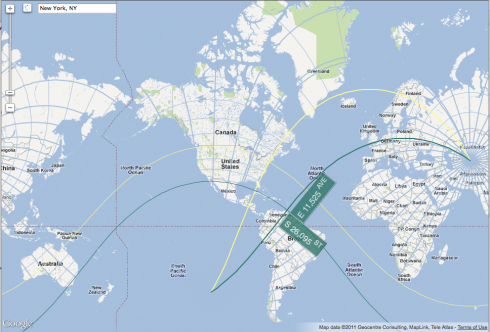
Just goes to show that everything is relative.
Places to Visit
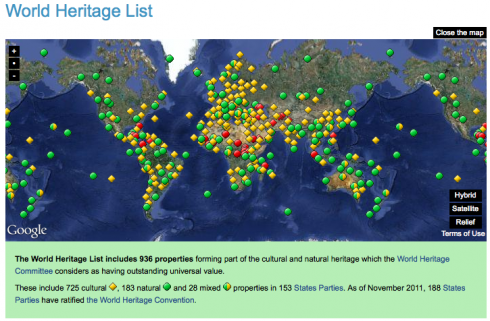
Cahokia‘s just one of almost a thousand sites around the world that UNESCO considers to form, “part of the cultural and natural heritage” of the world that has “outstanding universal value.”

It’s a remarkable selection of places, from natural geological wonders like the Grand Canyon, to biological preserves like Peru’s Manú National Park, to cultural landscapes like that of Bam, Iran.
The long, detailed descriptions of the importance of these sites makes the World Heritage List website is a remarkable resource for cultural and physical geography.
Cahokia Mounds
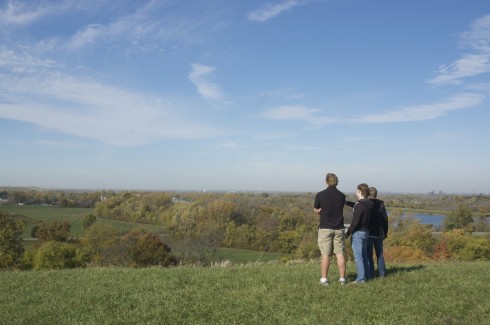
Almost a thousand years ago, 20,000 people lived at a place called Cahokia. At the center of their city, was the largest artificial mound in North America. A large part of Cahokia’s success is surely its location: near the confluence of the Mississippi and Missouri Rivers — just across the Mississippi from modern-day St. Louis. Yet less than 400 years later (see timeline) the city was abandoned, and no one is quite sure what happened.
Our middle and high school took a trip out to Cahokia last month. It was during the same intercession between quarters when we visited the Laumeier Sculpture Park, the Da Vinci Exhibition, and did our brief biological survey of the campus.
The elevation of the main mound, sitting on the flat Mississippi flood plain, with the St. Louis skyline in the distance, was a great place to talk about the importance of physical geography in the location of cities (your biggest cities are always going to be on rivers, or the ocean or, often, both) and to reflect on how history repeats itself — a once thriving metropolis is nothing now but displaced piles of alluvium and mystery.
View Cahokia in a larger map
Cahokia is a World Heritage Site, and it has an excellent museum. I particularly liked the detail in their life-sized reconstruction of a section of the city.
Their website is also good. Apart from the timeline, mentioned above, they have a nice interactive map for details about each of the numerous mounds, and a long page about the archeology.
The site is pretty big, so you can spend a fair amount of time exploring. Fall, when the leaves have turned color, and the air has cooled a little, is an excellent time to visit.
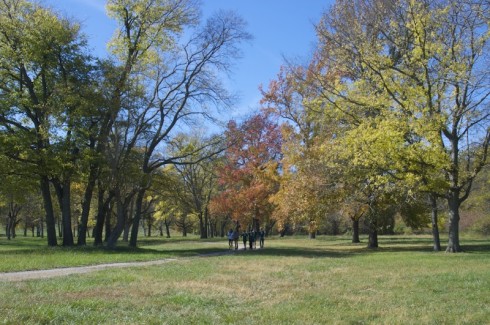
Morning Fog

There’s a place on the road to school where you crest a little rise and the St. Albans golf course opens up before you. “Zen-like,” I’ve heard it described. On one lovely fall morning last week the view was absolutely ridiculous. I had to stop.
Resisting the coming winter, warmer air from down south just pushed over the hills overnight, trapping the cooler air in the valley, creating a thermal inversion that trapped a layer of fog just below the tops of the hills. Small tendrils of mist were rising off lake in the bottom of the valley, feeding the fog layer as the cooler valley air condensed the water vapor evaporating off the still warm lake.
Combine the fog, mists, early morning sunlight just beginning to reach into the valley, and the brilliant fall colors contrasting against the still-green lawns, and the result was absolutely amazing.
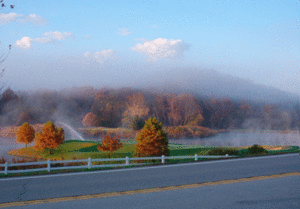
Zipline to School
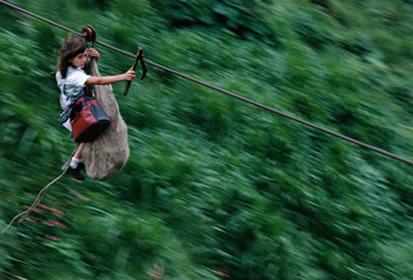
Photographer Christoph Otto has a few utterly amazing photographs of the kids of Rio Negro in Columbia, who have to take a zipline to get across the valley to school.
This video gives more details.
It might also be useful if students need some incentive to try the zipline at the challenge course.
